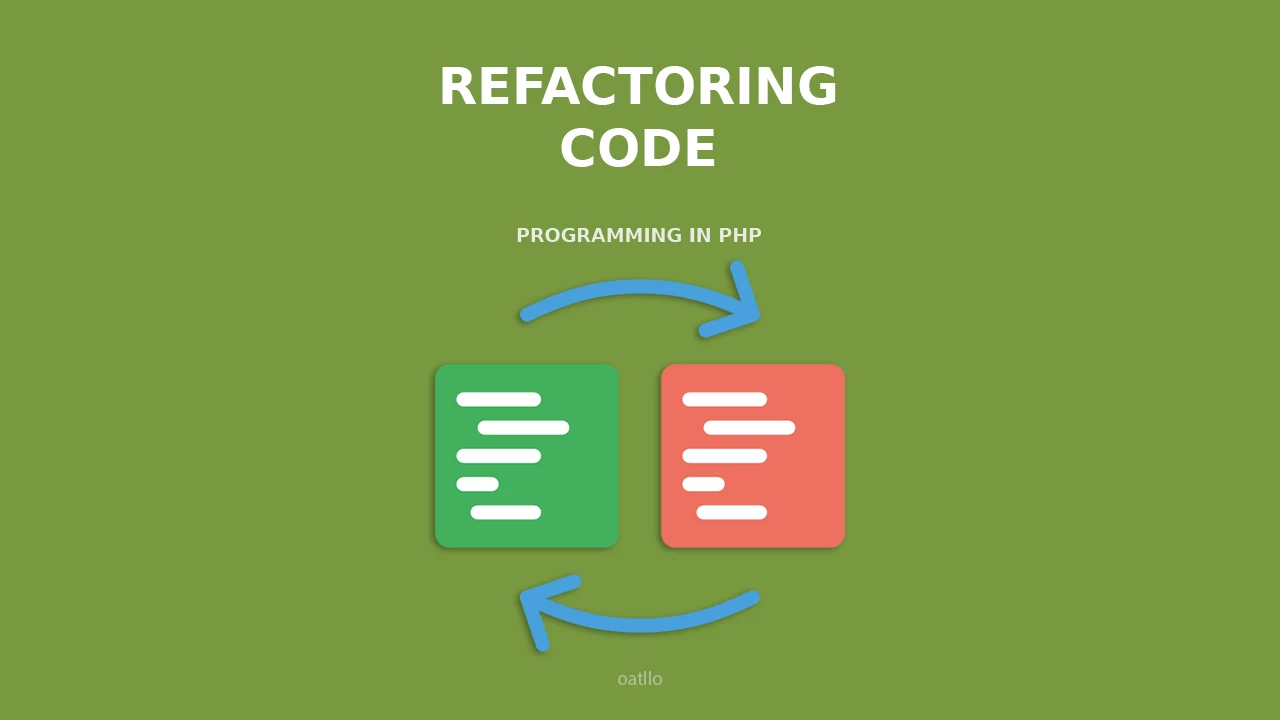Introduction to PHP Code Refactoring
When we think about the past, and more specifically about our old PHP projects, surely each of us has a few memories that evoke mixed feelings. On one hand, excitement from the moments when we created something new and thrilling. On the other hand, dark thoughts about the code that becomes unreadable and difficult to manage. This is where code refactoring comes to the rescue, like a superhero ready to save us from chaos. But what does it really mean?
PHP code refactoring is a process that involves making changes to existing code to improve its structure and readability, without changing functionality. It can be compared to a renovation of a house: we change the layout of the rooms, paint the walls, but ultimately we still have the same house. In the case of refactoring, it's about making our application work better, being easier to understand, and less prone to errors, while we as programmers feel more comfortable managing it.
So why is refactoring so important in PHP programming? The answer is simple: as programmers, we often have to work on a living organism. The code we wrote a few months ago may today seem opaque and chaotic, especially when several people are involved in the project, and over time we add new functionalities. It's not easy to implement new changes in code that is not well organized.
- Declare your variables
- Define your classes
- Handle your sessions
- But always keep your code clean
The cleaner the code, the easier it is to maintain. That is why refactoring can bring to our code what might be called a “breeze of freshness.” An example could be shortening the length of functions that previously contained too much code in a single method. This approach not only improves readability but also enhances performance through greater modularity. Imagine an artist painting a mural. Instead of using one big brush to paint a solid piece of the wall, they prefer to use smaller brushes for details. What results from that? A beautiful, understandable work.
Code refactoring also translates to application performance. When we get rid of excess code lines or optimize algorithms used for calculations, our application can run faster and more efficiently. And that can be crucial if we care about user satisfaction. Imagine that an application loads in a few seconds when we then decide on any upgrades. Now imagine a situation where loading takes longer due to improper solutions and outdated code, causing user frustration. And who wants to come back in such a case?
It's also worth adding that refactoring contributes to better testing and debugging of code. When our code is well organized, it becomes easier to understand, which in turn makes written unit tests and tracking down errors a real pleasure. Imagine you are a detective trying to solve a complex case. When you have all the clues in one place, the case seems less complicated and easier to solve.
Code Refactoring is like regularly reviewing and cleaning your apartment. Over time, various things accumulate in our daily lives: old books, unnecessary items, and sometimes even dirt on the shelves. In the realm of PHP code, disorder also builds up. Therefore, what was initially clear and well-organized can, after a while, become chaos. Why is it worth implementing refactoring? Well, the answer is simple – to maintain order and make the code more efficient.
One of the most important aspects of refactoring is improving code readability. Imagine coming back to a project after several months, facing code that looks like a labyrinth, making it impossible to distinguish one turn from another. Refactoring helps eliminate unreadable code blocks and introduces structures that clearly define what is happening and where. The clearer the code, the less time we spend searching for errors, and the greater the chance that we won’t introduce any at all. Interesting, right?
Code maintenance is another key element that developers pay attention to. With continuous project development, changes are inevitable. When...
...small details require improvement, and the code starts to resemble an unreadable soup, refactoring comes to the rescue. Sometimes we add new features that somehow need to fit into existing structures. Without refactoring, introducing a small change can carry a huge risk of breaking other elements of the code. Refactoring functions like a healthy diet, eliminating what is unnecessary while adding components that will make our application healthier.
Another advantage of refactoring is the reduction of error risks. Everyone knows how it feels when, after a long day at work, an unexpected error erupts in code that seemed completely stable. This unexpected disaster, like a meteor falling on a peaceful city, often leads to frustration within the development team. Regular refactoring reduces the likelihood of such incidents, as it eliminates hard-to-understand code snippets, where it is easy to make mistakes and overlook something.
Of course, we cannot forget about the ease of making changes. When the code becomes neglected, each addition feels like clogging a pipe in a plumbing system. Refactoring makes it so that introducing new features no longer feels like a painful experience and becomes much more enjoyable.
Let’s imagine a situation where we can freely develop our application, and adding new features isn’t a process reminiscent of climbing a steep mountain. Refactoring acts like a map that outlines paths through difficult terrain. Furthermore, in situations where an unpredictable number of users can flood our application, and we are forced to change the architecture, refactoring introduces flexibility in the code, significantly improving scalability. There’s nothing worse than an assault on our precious application in the face of a sudden spike in traffic. By adhering to the principle of refactoring, we not only gain better quality and performance but also build confidence in facing the challenges that may arise in the future.
When it comes to key refactoring techniques that can enhance the quality and performance of your PHP code, it's important to remember that refactoring is a process, not a one-time action. This can be compared to regular check-ups and maintenance of a car - when we pay attention to details, we drive better and cars break down less often. The same goes for code: the better we maintain it, the fewer problems we encounter in the future. So, what techniques should we consider to make our code more elegant and efficient?
Extracting functions is one of the simplest yet most effective refactoring techniques. When your code starts to resemble spaghetti, with many nested elements, it's time to look at those fragments and ask: "Can I simplify this?" If you notice that you have repeating blocks of code, consider extracting them into separate functions. This will make your code more modular and easier to maintain. An example? If you have calculations related to tax computation, repeating in various places, create a function that takes parameters and returns a result. That way, if you decide to change the basic calculation algorithm, you only need to update one function, not an entire set of related locations.
Reducing code duplication is another fundamental principle that greatly contributes to the refactoring process. Imagine you have code in your application that performs the same operation in different places. Sometimes, this can be compared to a poorly thought-out organization of all the documents in an office. It is known that the more times we duplicate something, the greater the risk that we will make a mistake. Create a central point for those repetitions - it can be a class, method, or even a set of functions. In PHP, we can use abstract classes and interfaces to centralize logic, for example. This way, you will not only avoid errors but also make your life easier for future fixes and changes in the application.
Before we start talking about design patterns, it’s worth emphasizing another point. In refactoring, it’s also essential to think about code readability. We often forget that code is not just a set of instructions for the computer, but also something that others (or ourselves in a few months) will need to read and understand. Clear, understandable method names, comments explaining harder parts of the code, and even formatting that facilitates browsing are crucial. Do you remember the last time you saw a piece of code that made you wonder what the author meant? Exactly. Well-written code is as much an art as a well-written book.
Using design patterns is another key component of refactoring. There are various patterns, such as:
- Singleton
- Factory
- Observer
- MVC
that help organize code in a more understandable and easier-to-maintain way. For instance, if we’re creating a system where many users will be sending data to the server, rather than writing chaotic procedures, we can apply the MVC pattern. This separates logic from representation, allowing for easier testing and modification of the solution in the future. Design patterns are nothing more than a set of proven solutions for frequently encountered problems, which allow us to achieve the best results missionally.
You've noticed that each of the mentioned techniques aims at simplifying and improving the quality of code, as well as increasing its performance. Refactoring is an art of continuous improvement. Just as the best dishes require time and care, we must also take care of our code to ensure it is always in optimal shape. Each of these techniques gives us the tools to create significantly better code and finally find time to fix issues that have escaped our attention for a long time.
/**
* Function to calculate tax
* @param float $amount The amount to calculate tax on
* @return float The calculated tax
*/
function calculateTax($amount) {
$taxRate = 0.23; // Set the tax rate
return $amount * $taxRate; // Return the calculated tax
}
// Example of using the function
$total = 1000;
$tax = calculateTax($total);
echo "The tax on $total is $tax.";
Code refactoring is like refreshing an old house. Sometimes it just takes changing a few details for everything to start working better, right?
By refactoring your PHP code, you gain not only increased performance but also improved quality. So how can you do this effectively? This is where analytical tools come into play, which, like architects of old buildings, point out what needs to be improved so that our application not only looks beautiful but is also functional.
For example, PHP CodeSniffer is a tool that analyzes our PHP code by comparing it to established coding standards. It’s like each of us having a personal programming teacher who ensures we don’t forget the most important rules.
With CodeSniffer, we can identify issues that may seem trivial, but in the long run, can lead to hard-to-solve problems. And believe me, no one wants to wander through a tangled mess of unreadable lines of code.
What specific problems can PHP CodeSniffer identify? For instance, it could point out inconsistencies in variable naming or excessive spaces.
Although these errors may seem insignificant, they actually steal our precious energy when we finally try to understand what we actually did. Refactoring is the moment we become aware of these traps and start eliminating them from our code.
Another tool worth having on your radar is PHPStan. This isn't just a regular detective; it’s a clever analyst that extracts golden insights from all compiled scripts and identifies issues with variable types that might slip through our fingers.
With PHPStan, we can prevent many potential errors that may arise at runtime. Beware – never underestimate the power of static analysis. It’s like buying a car with a specialized mechanic behind you, pointing out hidden defects!
Why is all this so important?
Well, imagine a situation where your project is growing, and your code is becoming increasingly complex. Every added piece of new functionality requires more attention to avoid causing disaster. Refactoring is your shield against chaos. By improving the quality of your code now, you save yourself from headaches and lost time in the future.
So how can we start this process?
The first step could be testing our code using the tools we discussed earlier. Let’s take a moment, look at the results, and plan what requires immediate attention.
It often happens that we first need to spend time on proper analysis before delving into deeper changes in the actual structure of the code. An example from daily life? Every time we clean the house, we first assess what we have before we start throwing away unnecessary stuff.
Refactoring PHP code is not just a trendy buzzword; it’s an art whose mastery can bring tangible benefits for both us, programmers, and our users. Users deserve faster, more efficient applications, and our code deserves a second chance to become something better.
And these tools are not just a luxury but rather a necessity in today’s programming landscape.
prepare($query);
// Execute the query
$stmt->execute();
// Return the results
return $stmt->fetchAll(PDO::FETCH_ASSOC);
}
?>
Wandering through the mazes of PHP code refactoring, we encounter many complex issues that can lead to significantly better application performance. Imagine your application as a racetrack – at some point on the track, there might be a traffic jam. And this is where refactoring comes in – it's nothing less than unblocking the jam, so everything can run smoothly like a well-oiled machine. By focusing on optimization, we start to see specific areas where we can gain, particularly regarding database queries and proper memory management.
Looking closely at database queries, we can identify potential culprits for slowdowns. There are many solutions:
- written more efficient SQL queries
- implementing indexes that significantly speed up data retrieval
This can be compared to a situation in which we do not know the way in an unfamiliar city. Without a map, every turn left or right might lead us nowhere, extending the time to our destination. In programming, the key is a well-designed and optimized data structure!
Performance bottlenecks in code are often a result of inadequate planning or a lack of advanced programming techniques. When we talk about refactoring, we not only eliminate unnecessary code snippets but also learn to analyze the space in which we operate. Let’s imagine a database as a container - if we keep too many items in one place without proper organization, we will eventually face problems with undesirable performance fluctuations.
Optimizing queries and navigating through the database structure are the most important aspects of this game. Sometimes tens or thousands of queries can be reduced to just a few, allowing us to save a significant amount of time.
When we talk about performance, we must not forget about memory management. Memory in web applications running on PHP is nothing more than a ceremony in ballet - everything must be perfectly choreographed, otherwise, a small mistake can bring the entire performance crashing down. Therefore, let's use tools such as memory profilers to determine which parts of the code consume the most memory. With them, we can locate problems and create more elegant solutions. Simply put, it's not just about achieving higher speed but also maintaining stability.
By transforming our code, we arrive at another aspect of refactoring, with particular emphasis on code architecture. Instead of chaos, it's better to impose a structure, which allows us to reduce the costs associated with monitoring performance and maintaining code in the long term.
Our adventures with code refactoring in PHP thus show that improving application performance often relies on understanding the fundamentals. This understanding not only allows us to identify bottlenecks but also provides the tools to eliminate them. Once we do this, the path to a more optimized and responsive application becomes clear like a summer morning, ready to accommodate the growing number of users.
If you think that PHP code refactoring is merely a technical process that takes place in the shadow of a computer screen, let me present a few examples that will make you look at this issue in a completely different way. Imagine that your code is an invisible machine that drives your application. Sometimes we can notice that it’s not working as smoothly as it used to; it may get stuck, and its performance decreases. And it’s precisely in such moments that refactoring comes in handy – our magic keys that can unlock the doors to improving the performance and quality of your software.
An exceptionally exciting example is refactoring using function grouping. Let's assume that in our code, we have somewhat messy functions that duplicate each other’s logic. Suppose we have two functions: getUserData and getAdminData. Both of these functions perform similar tasks, but each one has its own implementation set, which increases the number of code lines and complicates maintenance.
When we take a closer look, we can create one updated function that accepts an additional parameter regarding user permissions. Here’s an example:
// Before refactoring
function getUserData($userId) {
// Logic to get user data
}
function getAdminData($adminId) {
// Logic to get admin data
}
// After refactoring
function getData($id, $isAdmin = false) {
// Logic to get data based on user type
}
As a result of refactoring, our code not only becomes more concise but also significantly easier to understand and maintain. People working with this code in the future may notice that changes in user promotions will cause fewer issues because all logic is condensed into one function, thus minimizing the risk of changing something in the wrong place that affects other protocols. Performance increases, and the quality of the code goes up.
This example shows how caring for order in code is much more than just a technical whim. It’s a philosophy that contributes to the longer usability of applications on the market and saves developers' time in future projects. Another aspect worth considering during refactoring is comments and documentation – especially in longer projects where teams might change. Comments may seem unnecessary, but the truth is that a well-written comment acts like a treasure map in the maze of advanced code.
Thus, an example of refactoring comments could look like this:
// Before refactoring
function calculateScore($score, $bonus) {
return $score + $bonus; // Adding bonus to score
}
// After refactoring
/**
* Calculates the total score by adding bonus to the base score.
*
* @param int $score Base score.
* @param int $bonus Bonus points to add.
* @return int Total score after addition.
*/
function calculateTotalScore($score, $bonus) {
return $score + $bonus;
}
By using documentation, every programmer who comes after us will understand what we did and why. Refactoring comments makes the code more accessible, which ultimately translates to better quality teamwork on the project.
Let's take another example – preventing code duplication. This is one of the main sins in programming. Some programmers think: "But it's just a few lines, it can't hurt to add this again!" And then it turns out that those few lines have turned into hundreds, and we are well on our way to creating a “code monster” with many little gorgons lurking in dark corners. Let’s say we have a code snippet that is duplicated several times:
// Before refactoring
function generateReport1($data) {
// Code to generate report
}
function generateReport2($data) {
// Code to generate report
}
// After refactoring
function generateReport($data) {
// Unified code to generate report
}
When we compare these two pieces of code, we can see that refactoring allows for a reduction in code size and improves its understandability. And when you add new functionality, you only need to change one function instead of hundreds of duplicates. As you can see, proper code organization supports organized teamwork, which translates to better quality and higher efficiency.
Refactoring code in PHP is not just fluff - it's a real process that brings benefits both to the code and to those who work on it. Every improvement that we can implement in even the smallest piece of code will pay us back many times over.
You have certainly noticed how many elements of a software development team can influence the quality and performance of our code. How can you be sure that your approach to refactoring not only meets the standards but also accelerates the development of your project? Well, a key phenomenon that remains in our memory is the practice of using unit tests, continuous integration, and well-organized documentation of the code.
One of the most important tools in our arsenal is documentation; it is a guide for other developers who may use our code. If you do not care about its quality, it may turn out that the best practices in refactoring will lose significance.
As one of my mentors used to say, “documentation is love for the future,” and every presented piece of code can gain value. I will give you a recipe for good documentation of changes: shortly, succinctly, and most importantly clearly. Not every programmer is a genius, and a simple instruction can save the day.
When we move on to unit tests, it should be remembered that in the age of modern programming we cannot ignore them. Refactoring PHP code without appropriate tests is like climbing a high mountain without protection. None of us wants to see our code falling into an abyss full of errors.
Therefore, before you start refactoring, make sure that your unit test suite is fully functional. Let's assume we have a function that calculates the sum of two numbers. If you don’t test it before refactoring, you risk that after making changes, something will go wrong, and your carefully crafted work will collapse like a house of cards.
On the other hand, well-written tests will help catch errors early, which will significantly save time and nerves.
Finally, let’s focus on continuous integration. This principle is like the foundation on which you build your dreams of an efficient application. A well-organized CI/CD system is essential in today’s world. Imagine how wonderful it would be if your code changes could be automated and sent for medium-term testing right after implementation. Magical? Absolutely! Thanks to this practice, every small change is tested in the context of the entire system, which reduces the risk of errors in production.
This also allows for quick problem detection, before they become major complications.
The guiding principles we have presented aim to streamline the refactoring process in your project. Sometimes it may seem like a lot of work, but remember that code quality brings huge benefits in the long term, and the effects will not be delayed.
- Time savings
- Better performance
- Lower risk of errors
are just some of the forthcoming benefits. So, as you explore the world of code refactoring, keep these principles in mind and implement them, and your code will not only work better but also look its best in the hands of any programmer who glances at it.
And the rapid gain in quality is just the cherry on top!










